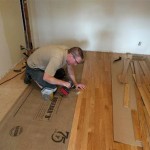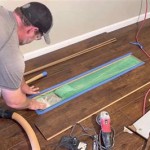Can I Use Concrete to Level a Floor in My Basement? A Comprehensive Guide
Leveling a basement floor is a common task undertaken by homeowners seeking to improve the usability and functionality of their below-grade space. Uneven floors can lead to a variety of issues, including difficulty installing flooring, structural concerns, and aesthetic imperfections. Concrete, due to its inherent strength and relatively low cost, is a frequently considered material for this purpose. This article will delve into the feasibility, methods, advantages, and disadvantages of using concrete to level a basement floor, providing a detailed overview for informed decision-making.
The suitability of concrete for leveling a basement floor is contingent upon several factors, primarily the extent and nature of the unevenness. Minor deviations, such as slight dips or imperfections, may be effectively addressed with a thin layer of concrete, often referred to as a self-leveling concrete compound. However, significant variations in floor height, extensive cracking, or structural issues may necessitate more extensive and involved repair methods. Before embarking on any leveling project, a thorough assessment of the existing floor is crucial.
Proper preparation is paramount for the successful application of a concrete leveling solution. This involves cleaning the existing floor to remove any debris, dust, grease, or loose particles that could compromise the bond between the new concrete layer and the existing floor. Cracks and larger holes must be addressed prior to the application of the leveling compound. These may require patching with a concrete repair mortar or epoxy filler. Depending on the existing substrate, a bonding agent may also be required to promote adhesion. This agent is typically a liquid applied to the cleaned surface before the concrete is poured.
Understanding the Types of Concrete for Leveling
When considering concrete for leveling a basement floor, it's important to differentiate between traditional concrete mixes and self-leveling concrete compounds. Traditional concrete, a mixture of cement, aggregate, and water, is typically used for structural applications and requires significant manual labor to spread and level. Self-leveling concrete, on the other hand, is a specialized formulation designed to flow easily and spread evenly under its own weight. This characteristic makes it particularly suitable for leveling floors, especially when dealing with minor to moderate unevenness.
Self-leveling concrete compounds often contain polymers and other additives that enhance their flowability, reduce shrinkage, and improve adhesion. They are usually mixed with water according to the manufacturer's instructions to achieve the desired consistency. Once poured, the self-leveling compound will spread out and fill in low spots, creating a smooth and level surface. While generally more expensive than traditional concrete, the ease of application and reduced labor costs associated with self-leveling compounds often make them a cost-effective solution.
The choice between traditional concrete and self-leveling concrete depends largely on the nature and extent of the floor imperfections. For minor imperfections, self-leveling concrete is generally the preferred option due to its ease of use and superior leveling capabilities. For larger areas requiring significant thickness, a combination of traditional concrete for the bulk fill and a self-leveling compound for the final surface layer may be a more economical and practical approach.
The Process of Applying Concrete for Leveling
The application process for concrete leveling involves several key steps, each critical for achieving a successful outcome. As mentioned previously, thorough preparation of the existing floor is essential. This includes cleaning, patching cracks, and applying a bonding agent if necessary. Once the floor is prepared, the concrete mixture, whether traditional or self-leveling, needs to be properly mixed according to the manufacturer's recommendations. Accurate measurements of water and powder are crucial for achieving the desired consistency and performance.
For traditional concrete, the mixture is typically poured onto the floor and spread using a screed board or other leveling tool. The process requires skill and experience to achieve a smooth and level surface. Self-leveling concrete, on the other hand, is poured onto the floor and allowed to flow naturally. A gauge rake or similar tool can be used to gently guide the flow and ensure even distribution. It is important to work quickly, as self-leveling compounds have a limited working time before they begin to set.
After the concrete has been poured and leveled, it is essential to allow it to cure properly. Curing involves keeping the concrete moist for a specified period, typically several days, to allow the cement to hydrate fully and gain strength. This can be achieved by covering the concrete with plastic sheeting or regularly misting it with water. Proper curing is crucial for preventing cracking and ensuring the long-term durability of the leveled floor.
Potential Challenges and Considerations
While concrete can be an effective solution for leveling a basement floor, several potential challenges and considerations must be addressed. One of the primary concerns is the potential for moisture infiltration. Basements are inherently prone to moisture issues, and any concrete application must be accompanied by appropriate waterproofing measures to prevent water damage. This may involve applying a waterproof membrane to the exterior of the foundation walls or installing a drainage system to divert water away from the basement.
Another consideration is the load-bearing capacity of the existing floor. Adding a significant layer of concrete can increase the overall weight on the floor slab, which could potentially lead to structural problems if the floor is not adequately reinforced. A structural engineer should be consulted to assess the load-bearing capacity of the existing floor and determine if any additional reinforcement is required. This is especially critical in older homes or those with known structural issues.
Furthermore, the application of concrete can alter the floor height, which may affect doorways, stairs, and other architectural features. Careful planning is necessary to ensure that the leveling process does not create accessibility issues or require modifications to other parts of the basement. The added thickness of the concrete should be factored into the overall design to avoid creating tripping hazards or other safety concerns.
In conclusion, using concrete to level a basement floor is a viable option, but it necessitates careful planning, preparation, and execution. It is imperative to assess the existing floor conditions, select the appropriate type of concrete, and address any potential challenges related to moisture, load-bearing capacity, and accessibility. Consulting with experienced professionals, such as concrete contractors or structural engineers, is highly recommended to ensure a successful and durable outcome.
The long-term performance of a concrete leveled basement floor is dependent on several factors, including the quality of the materials used, the skill of the installer, and the ongoing maintenance provided. Regular inspections should be conducted to identify any signs of cracking, moisture damage, or other problems. Prompt repairs should be made to prevent minor issues from escalating into more serious concerns. By taking a proactive approach to maintenance, homeowners can ensure that their concrete leveled basement floor remains level, stable, and aesthetically pleasing for many years to come.

Adding Self Leveling Concrete To A Basement Floor Daniel Kanter

2 Ways To Level An Uneven Basement Floor The Real Seal Llc

Adding Self Leveling Concrete To A Basement Floor Daniel Kanter

Self Level A Painted Concrete Basement Floor Little Diy

Self Leveling Concrete Diy Tips Cost When Not To Use It

Adding Self Leveling Concrete To A Basement Floor Daniel Kanter

How To Level An Uneven Basement Floor

Self Level A Painted Concrete Basement Floor Little Diy

Adding Self Leveling Concrete To A Basement Floor Daniel Kanter

Concrete Floor Leveling Everything You Need To Know
See Also







